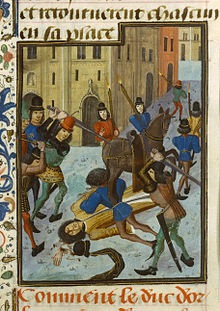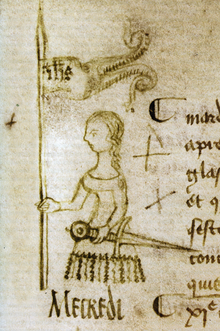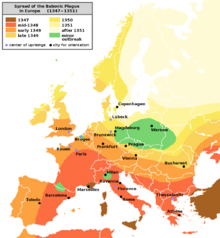Hundred Years' War
The outbreak of war was motivated by a gradual rise in tension between the kings of France and England over territory; the official pretext was the interruption of the direct male line of the Capetian dynasty.French monarchs systematically sought to check the growth of English power, stripping away lands as the opportunity arose, mainly whenever England was at war with Scotland, an ally of France.The newly crowned Henry V of England seized the opportunity presented by the mental illness of Charles VI of France and the French civil war between Armagnacs and Burgundians to revive the conflict.The economic consequences of the Hundred Years' War not only produced a decline in trade but also led to a high collection of taxes from both countries, which played a significant role in civil disorder.Given the situation, Philip, Count of Poitiers and brother of Louis X, positioned himself to take the crown, advancing the stance that women should be ineligible to succeed to the French throne.He won over his adversaries through his political sagacity and succeeded to the French throne as Philip V. When he died in 1322, leaving only daughters behind, the crown passed to his younger brother, Charles IV.Moreover, the French nobility balked at the prospect of being ruled by an Englishman, especially one whose mother, Isabella, and her lover, Roger Mortimer, were widely suspected of having murdered the previous English king, Edward II.Therefore, excluding Edward, the nearest heir through the male line was Charles IV's first cousin, Philip, Count of Valois, and it was decided that he should take the throne.However, Philip II of France acted decisively to exploit the weaknesses of John, both legally and militarily, and by 1204 had succeeded in taking control of much of the Angevin continental possessions.King David II of Scotland responded by invading northern England, but his army was defeated, and he was captured at the Battle of Neville's Cross on 17 October 1346.In no wise did they defend their country from its enemies; rather did they trample it underfoot, robbing and pillaging the peasants' goods ...Edward invaded France, for the third and last time, hoping to capitalise on the discontent and seize the throne.In return for increased lands in Aquitaine, Edward renounced Normandy, Touraine, Anjou and Maine and consented to reduce King John's ransom by a million crowns.[34][41] The French crown had been at odds with Navarre (near southern Gascony) since 1354, and in 1363, the Navarrese used the captivity of John II in London and the political weakness of the Dauphin to try to seize power.French forces were led by Bertrand du Guesclin, a Breton, who rose from relatively humble beginnings to prominence as one of France's war leaders.[57] In February, reconciled to the regime of the new French king Charles VI by the Treaty of Guérande, Brittany paid 50,000 francs to Buckingham for him to abandon the siege and the campaign.With France facing widespread destruction, plague, and economic recession, high taxation put a heavy burden on the French peasantry and urban communities.The war effort against England largely depended on royal taxation, but the population was increasingly unwilling to pay for it, as would be demonstrated at the Harelle and Maillotin revolts in 1382.Philip II of Burgundy, the uncle of the French king, brought together a Burgundian-French army and a fleet of 1,200 ships near the Zeeland town of Sluis in the summer and autumn of 1386 to attempt an invasion of England, but this venture failed.However, Philip's brother John of Berry appeared deliberately late, so that the autumn weather prevented the fleet from leaving and the invading army then dispersed again.[59] Richard II's indifference to the war together with his preferential treatment of a select few close friends and advisors angered an alliance of lords that included one of his uncles.Although the will was there, the funds to pay the troops was lacking, so in the autumn of 1388 the Council agreed to resume negotiations with the French crown, beginning on 18 June 1389 with the signing of the three-year Truce of Leulinghem.[54][61] In Scotland, the problems brought in by the English regime change prompted border raids that were countered by an invasion in 1402 and the defeat of a Scottish army at the Battle of Homildon Hill.In 1405, the French allied with Glyndŵr and the Castilians in Spain; a Franco-Welsh army advanced as far as Worcester, while the Spaniards used galleys to raid and burn all the way from Cornwall to Southampton, before taking refuge in Harfleur for the winter.[70] Henry accredited envoys to the French king to make clear his territorial claims in France; he also demanded the hand of Charles VI's youngest daughter Catherine of Valois.In a campaign reminiscent of Crécy, he found himself outmanoeuvred and low on supplies and had to fight a much larger French army at the Battle of Agincourt, north of the Somme.The Duke of Clarence engaged a Franco-Scottish force of 5000 men, led by Gilbert Motier de La Fayette and John Stewart, Earl of Buchan at the Battle of Baugé.A few days after the congress ended in September, Philip the Good, duke of Burgundy, deserted to Charles VII, signing the Treaty of Arras that returned Paris to the King of France.[79] The allegiance of Burgundy remained fickle, but the Burgundian focus on expanding their domains in the Low Countries left them little energy to intervene in the rest of France.Louis managed to isolate the Burgundians by buying Edward IV of England off with a large cash sum and an annual pension, in the Treaty of Picquigny (1475).By the war's end, although the heavy cavalry was still considered the most powerful unit in an army, the heavily armoured horse had to deal with several tactics developed to deny or mitigate its effective use on a battlefield.


France before 1214
French acquisitions until 1330
England and Guyenne/Gascony as of 1330


















First Hundred Years' WarSecond Hundred Years' WarHundred Years' Croatian–Ottoman WarCrisis of the late Middle AgesAnglo-French WarsBattle of La RochelleBattle of AgincourtBattle of PatayJoan of ArcSiege of OrléansFranceLow CountriesGreat BritainIberian PeninsulaEnglandcontinental possessionsPale of CalaisKingdom of FranceHouse of ValoisKingdom of EnglandHouse of PlantagenetBurgundian StateDuchy of BrittanyCrown of CastileKingdom of ScotlandWelsh rebelsCrown of AragonKingdom of PortugalKingdom of NavarreDuchy of GasconyPhilip VIJohn IICharles VCharles VICharles VIILouis, DauphinGilles de RaisBertrand du GuesclinPhilip the BoldJohn the FearlessOwain GlyndŵrPhilip the GoodCharles of BloisDavid IIJohn StewartHenry of TrastámaraJohn IEdward IIIRichard IIHenry IVHenry VHenry VIThe Black PrinceJohn of GauntRichard of YorkJohn of LancasterHenry of LancasterJean III de GraillyThomas MontacuteJohn TalbotJohn FastolfRobert d'ArtoisJohn of MontfortEdwardian phase(1337–1360)CadzandArnemuidenEnglish ChannelThiérache campaignCambraiScheldt campaignsTournaisis campaignSaint-OmerTournaiMorlaixEdward III's Breton campaign1345–1347GasconyBergeracAuberocheAiguillonCrécy campaignBlanchetaqueCrécyCalais (1346–1347)Lancaster's chevauchée (1346)LunalongeCalais (1350)WinchelseaSaint-Jean-d'AngélySaintesArdresGuînesBlack Prince's chevauchée (1355)Edward III's chevauchée (1355)Normandy chevauchée (1356)BreteuilLoire campaign (1356)Black Prince's chevauchée (1356)PoitiersJacquerieReims campaignChartresEspléchinMalestroitCalaisFirst LondonSecond LondonBrétignyWar of the Breton SuccessionInitial campaignVannesHennebontTruce of MalestroitCadoretSaint-Pol-de-LéonLa Roche-DerrienThe ThirtyMauronMontmuranRennesTreaty of GuérandeCaroline phase (1369–1389)CocherelLimogesPontvallainLa Rochelle